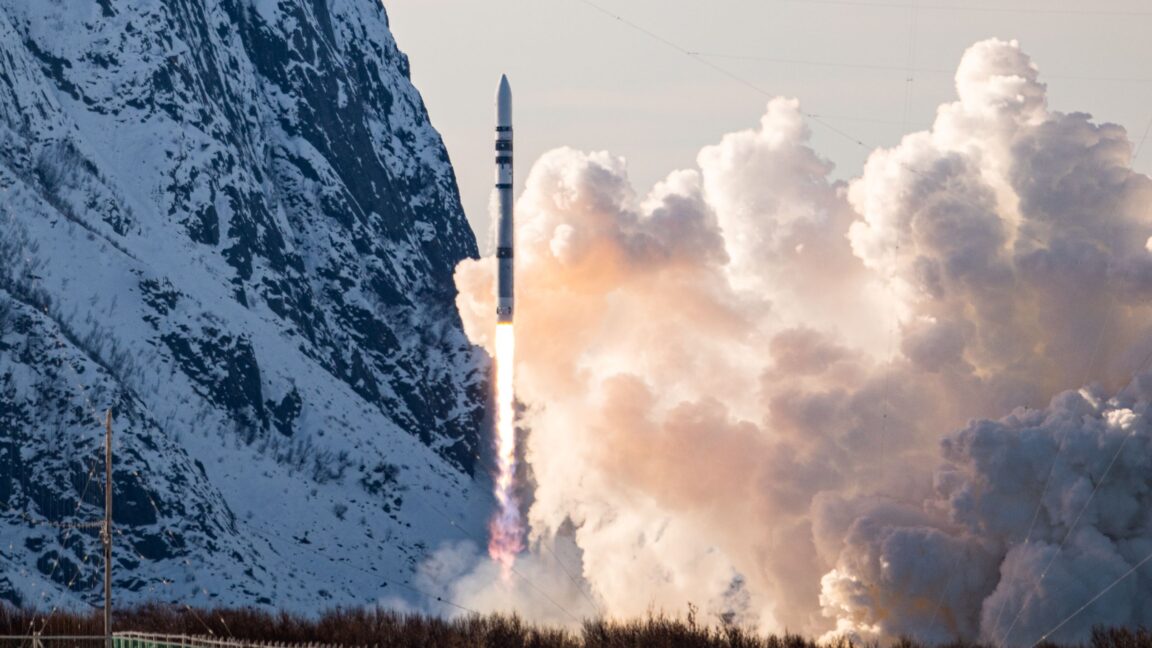
Welcome to Edition 8.11 of the Rocket Report! We have reached the time of year when it is possible the US government will shut down its operations at the end of this month, depending on congressional action. A shutdown would have significant implications for many NASA missions, but most notably a couple of dozen in the science directorate that the White House would like to shut down. At Ars, we will be watching this issue closely in the coming days. As for Artemis II, it seems to be far enough along that a launch next February seems possible as long as any government closure does not drag on for weeks and weeks.
As always, we welcome reader submissions, and if you don’t want to miss an issue, please subscribe using the box below (the form will not appear on AMP-enabled versions of the site). Each report will include information on small-, medium-, and heavy-lift rockets as well as a quick look ahead at the next three launches on the calendar.
Rocket Lab to sell common shares. The space company said Tuesday that it intends to raise up to $750 million by selling common shares, MSN reports. This new at-the-market program replaces a prior agreement that allowed Rocket Lab to sell up to $500 million of stock. Under that earlier arrangement, the company had sold roughly $396.6 million in shares before ending the program.
Seeking to scale up … The program’s structure enables Rocket Lab to sell shares periodically through the appointed agents, who may act as either principals or intermediaries. The larger offering indicates that Rocket Lab is aiming to bolster its cash reserves to support ongoing development of its launch services, including the medium-lift Neutron rocket and spacecraft manufacturing operations. The company’s stock dropped by about 10 percent after the announcement.
Astra targets mid-2026 for Rocket 4 debut. Astra is targeting next summer for the first flight of its Rocket 4 vehicle as the company prepares to reenter the launch market, Space News reports. At the World Space Business Week conference in Paris, Chris Kemp, chief executive of Astra, said the company was on track for a first launch of Rocket 4 in summer 2026 from Cape Canaveral, Florida. He highlighted progress Astra is making, such as tests of a new engine the company developed for the vehicle’s first stage that produces 42,000 pounds of thrust. Two of those engines will power the first stage, while the upper stage will use a single Hadley engine produced by Ursa Major.
Pricing a launch competitively … The vehicle will initially be capable of placing about 750 kilograms into low-Earth orbit for a price of $5 million. “That’ll be very competitive,” Kemp said in an interview after the presentation, similar to what SpaceX charges for payloads of that size through its rideshare program. The company is targeting customers seeking alternatives to SpaceX in a constrained launch market. “There’s a lot of interest because of the fear that there’s just not a lot of capacity,” he said, particularly for satellites too large to launch on Rocket Lab’s Electron. (submitted by EllPeaTea)
The Ars Technica Rocket Report
The easiest way to keep up with Eric Berger’s and Stephen Clark’s reporting on all things space is to sign up for our newsletter. We’ll collect their stories and deliver them straight to your inbox.
Sign Me Up!
Avio seeks to raise 400 million euros. Italian rocket builder Avio’s board of directors has approved a 400 million euro ($471 million) capital increase to fund an expansion of its manufacturing capacity to meet rising demand in the global space and defense markets, European Spaceflight reports. The company expects to complete the capital increase by the end of the year; however, it is still subject to a shareholder vote, scheduled for October 23.
Small rockets, big plans … The capital raise is part of a new 10-year business plan targeting an average annual growth rate of about 10 percent in turnover and more than 15 percent in core profit. This growth is projected to be driven by a higher Vega C launch cadence, the introduction of the Vega E rocket, continued participation in the Ariane 6 program by providing solid rocket boosters, and the construction of a new defense production facility in the United States, which is expected to be completed by 2028.
Isar working toward second Spectrum launch. In a briefing this week, Isar Aerospace executives discussed the outcome of the investigation into the March 30 launch of the Spectrum rocket from the Andøya Spaceport in northern Norway, Space News reports. The vehicle activated its flight termination system about half a minute after liftoff, shutting down its engines and plummeting into the waters just offshore of the pad. The primary issue with the rocket was a loss of attitude control.
Bend it like Spectrum … Alexandre Dalloneau, vice president of mission and launch operations at Isar, said that the company had not properly characterized bending modes of the vehicle at liftoff. Despite the failure to get to orbit, Dalloneau considers the first Spectrum launch a successful test flight. The company is working toward a second flight of Spectrum, which will take place “as soon as possible,” Dalloneau said. He did not give a specific target launch date, but officials indicated they were hoping to launch near the end of this year or early next year. (submitted by EllPeaTea)
Callisto rocket test delayed again. A new document from the French space agency CNES has revealed that the inaugural flight of the Callisto reusable rocket demonstrator has slipped from 2026 to 2027, European Spaceflight reports. This reusable launch testbed is a decade old. Conceived in 2015, the Cooperative Action Leading to Launcher Innovation in Stage Toss-back Operations (Callisto) project is a collaboration between CNES and the German and Japanese space agencies aimed at maturing reusable rocket technology for future European and Japanese launch systems.
Still waiting … The Callisto demonstrator will stand 14 meters tall, with a width of 1.1 meters and a takeoff mass of 3,500 kilograms. This latest revision to the program’s timeline comes less than a year after JAXA confirmed in October 2024 that the program’s flight-test campaign had been pushed to 2026. The campaign will be carried out from the Guiana Space Centre in French Guiana and will include an integration phase followed by eight test flights and two demonstration flights, all to be completed over a period of eight months. (submitted by EllPeaTea)
Falcon 9 launches larger Cygnus spacecraft. The first flight of Northrop’s upgraded Cygnus spacecraft, called Cygnus XL, launched Sunday evening from Cape Canaveral Space Force Station, Florida, en route to the International Space Station, Ars reports. Without a rocket of its own, Northrop Grumman inked a contract with SpaceX for three Falcon 9 launches to carry the resupply missions until engineers could develop a new, all-domestic version of the Antares rocket. Sunday’s launch was the last of these three Falcon 9 flights. Northrop is partnering with Firefly Aerospace on a new rocket, the Antares 330, using a new US-made booster stage and engines.
A few teething issues … This new rocket won’t be ready to fly until late 2026, at the earliest, somewhat later than Northrop officials originally hoped. The company confirmed it has purchased a fourth Falcon 9 launch from SpaceX for the next Cygnus cargo mission in the first half of next year, in a bid to bridge the gap until the debut of the Antares 330 rocket. Due to problems with the propulsion system on the larger Cygnus vehicle, its arrival at the space station was delayed. But the vehicle successfully reached the station on Thursday, carrying a record 11,000 pounds of cargo.
Launch companies still struggling with cadence. Launch companies are reiterating plans to sharply increase flight rates to meet growing government and commercial demand, even as some fall short of earlier projections, Space News reports. Executives speaking at a September 15 panel at the World Space Business Week conference highlighted efforts to scale up flights of new vehicles that have entered service in the last two years. “The key for us is cadence,” said Laura Maginnis, vice president of New Glenn mission management at Blue Origin. However, the publication notes, at this time last year, Blue Origin was projecting eight to 10 New Glenn launches this year. There has been one.
It’s difficult to go from 1 to 100 … Blue Origin is not alone in falling short of forecasts. United Launch Alliance projected 20 launches in 2025 between the Atlas 5 and Vulcan Centaur, but in August, CEO Tory Bruno said the company now expects nine. As recently as June, Arianespace projected five Ariane 6 launches this year, including the debut of the more powerful Ariane 64, with four solid-rocket boosters, but has completed only two Ariane 62 flights, including one in August.
NASA makes some modifications to SLS for Artemis II. This week, the space agency declared the SLS rocket is now “ready” to fly crew for the Artemis II mission early next year. However, NASA and its contractors did make some modest changes after the first flight of the booster in late 2022. For example, the Artemis II rocket includes an improved navigation system compared to Artemis I. Its communications capability has also been improved by repositioning antennas on the rocket to ensure continuous communications with the ground.
Not good, but bad vibrations … Additionally, SLS will jettison the spent boosters four seconds earlier during the Artemis II ascent than occurred during Artemis I. Dropping the boosters several seconds closer to the end of their burn will give engineers flight data to correlate with projections that shedding the boosters several seconds sooner will yield approximately 1,600 pounds of payload to Earth orbit for future SLS flights. During the Artemis I test flight, the SLS rocket experienced higher-than-expected vibrations near the solid rocket booster attachment points that were caused by unsteady airflow. To steady the airflow, a pair of 6-foot-long strakes flank each booster’s forward connection points on the SLS intertank.
Federal judge sides with SpaceX, FAA. The initial launch of Starship in April 2023 spread debris across a wide area, sending pulverized concrete as far as six miles away as the vehicle tore up the launch pad. After this, environmental groups and other organizations sued the FAA when the federal organization reviewed the environmental impact of this launch and cleared SpaceX to launch again several months later. A federal judge in Washington, DC, ruled this week that the FAA did not violate environmental laws as part of this review, the San Antonio Express-News reports.
Decision grounded within reason … In his opinion issued Monday, Judge Carl Nichols determined the process was not capricious, writing, “Most of the (programmatic environmental assessment’s) conclusions were well-reasoned and supported by the record, and while parts of its analysis left something to be desired, even those parts fell ‘within a broad zone of reasonableness.'” The environmental organizations said they were considering the next steps for the case and a potential appeal. (submitted by RP)
Next three launches
September 13: Falcon 9 | Starlink 17-12 | Vandenberg Space Force Base, California | 15:44 UTC
September 21: Falcon 9 | Starlink 10-27 | Cape Canaveral Space Force Station, Florida | 09:20 UTC
September 21: Falcon 9 | NROL-48 | Vandenberg Space Force Base, California | 17:23 UTC



